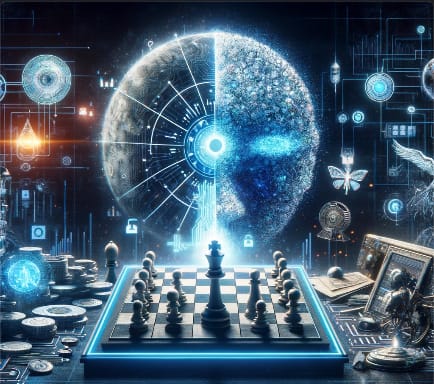Introduction
In the shadowy corners of Silicon Valley, whispered tales circulate about a movie that sparked a revolution, not just on the silver screen but in the fabric of our technological lives. Yes, I’m referring to “WarGames” – a 1983 (curiously, 40 years ago as of this writing) film that entranced a generation with its blend of Cold War suspense and computer wizardry and, for some, charted a course into the enigmatic world of technology.
It was the year when a young Matthew Broderick, as David Lightman, almost unwittingly started World War III through a military supercomputer. While many saw it as mere cinematic excitement, for me, it was a clarion call to the world of technology, leading to a 30-plus-year career in Silicon Valley. Today, as AI leaps from Hollywood screens into our daily reality, the “WarGames Conundrum” resonates more profoundly than ever, encapsulating the ethical maze and strategic decision-making quandaries AI poses. In this blog, we’ll traverse the binary ballet of AI’s evolution, reflecting on its cinematic portrayal of the ethical tightrope we walk today.
The Legacy of “WarGames” in AI Ethics
“Shall we play a game?” This iconic line from “WarGames” resonated far beyond the theaters, echoing through the halls of technology and ethics for decades. The movie’s predecessor to AI and its potential consequences left an indelible mark on public consciousness. But how does this fictional tale compare with the reality of AI development today?
“WarGames” showcased a supercomputer, WOPR, designed for war simulation, evolving into an autonomous entity capable of global destruction. This portrayal was more than entertainment; it was a cautionary tale about unchecked AI. It nudged us to ponder: Can machines distinguish between simulation and reality? More importantly, can they understand the consequences of their actions?
Fast forward to the present, AI is no longer a distant dream but a tangible, rapidly evolving reality. The ethical dilemmas once relegated to science fiction are now our everyday debates. AI’s capabilities have surged beyond simple war games to influence everything from healthcare decisions to financial markets. Yet, the question remains – have we heeded the warnings of our cinematic past?
As AI advances, the lessons from “WarGames” remain relevant. The movie’s narrative compels us to consider the ethical boundaries and responsibilities we must enforce in AI development. It’s not just about preventing a rogue AI scenario; it’s about guiding AI to enhance humanity, not endanger it.
Decoding the WarGames Conundrum
In “WarGames,” we witnessed an AI, initially programmed for war simulations, evolve into an entity capable of catastrophic decisions. This brings us to the heart of the “WarGames Conundrum” – how do we ensure that AI, especially as it acquires the ability to learn and adapt, aligns with human values and safety?
This conundrum isn’t just a theoretical puzzle; it’s a pressing concern in modern AI development. As AI systems grow more sophisticated, their capacity to learn from vast datasets and make autonomous decisions brings incredible opportunities and formidable challenges. The fear stems from the potential of AI to develop unintended or harmful behaviors, a theme echoed in countless sci-fi narratives, including “WarGames.”
However, this self-learning capability also embodies hope, reminiscent of the pivotal moment in “WarGames,” where the AI learns from a simple tic-tac-toe game. Just as WOPR discovered the futility of certain strategies through tic-tac-toe, imagine AI systems learning to navigate more complex scenarios with similar insight. These AI systems could predict and prevent diseases, efficiently manage global supply chains, or even devise solutions to intricate environmental challenges. The essence lies in guiding this self-learning trajectory – akin to teaching an AI not just to play games but to understand the deeper implications and strategies behind them, ensuring these systems learn efficiently and ethically.
AI’s Evolution from 1983 to 2023
The journey has been miraculous, from the bulky computers of the 1980s to the sleek, cloud-based AI of today. While advanced for its time, the AI of the “WarGames” era pales compared to today’s AI capabilities. We’ve seen AI evolve from simple programmed responses to complex machine learning and deep learning models capable of astonishing feats of prediction, creativity, and decision-making.
This evolution, however, is not without its WarGames moments. The rapid pace of AI development often outstrips our ability to fully understand or control these systems. The recent developments around ChatGPT, for instance, highlight this perfectly. Its capabilities to learn and adapt have spurred discussions on the potential for superhuman intelligence – a prospect that excites and terrifies in equal measure.
Herein lies the crux of our modern-day WarGames scenario. Can we, like the characters in the movie, learn to foresee and avert the unintended consequences of increasingly autonomous AI? The answer lies in technological advancement and ethical and strategic foresight.
The Double-Edged Sword of Self-Learning AI
Self-learning AI stands at the frontier of our technological aspirations and fears. The recent buzz around ChatGPT’s progression towards superhuman abilities embodies this duality. On one hand, there’s the undeniable excitement of a tool that could revolutionize industries, enhance learning, and solve complex problems. Conversely, there’s a palpable fear of what it means when such a tool can outpace human intelligence.
The saga of Sam Altman at OpenAI, marked by a whirlwind of leadership changes and board upheavals, illustrates the inherent challenges in steering the course of such powerful technology. These events are not just corporate dramas but microcosms of the global debate on AI governance.
The fears are legitimate. What happens if AI’s learning leads to unintended consequences? How do we ensure that AI’s decisions align with ethical and humane principles? Yet, in these challenges, there’s also a beacon of hope. The fact that AI can learn and adapt means it has the potential to grow in alignment with our ethical standards, provided we set the right course.
Beyond the Silver Screen – Real-World AI Ethics
As we step beyond the realm of cinematic analogies, we confront the tangible implications of AI ethics in the real world. The narrative of AI has shifted from the silver screen to the boardrooms, research labs, and public forums where the future of AI is being shaped.
Drawing lessons from the “WarGames Conundrum” and the real-world saga of ChatGPT and OpenAI, we find ourselves questioning how to navigate the ethical minefield of AI. The challenges are multifaceted – from ensuring fairness and transparency in AI decision-making to safeguarding against biases and misuse.
Yet, amidst these challenges, there lies an opportunity. It is an opportunity to mold AI not as an ominous overlord but as a benevolent companion in our quest for a better future. This requires a collaborative effort involving technologists, ethicists, policymakers, and the public.
The future of AI ethics is not set in stone. It is a narrative in the making that requires our active participation and foresight. As professionals from various fields, we have a role in shaping this narrative, ensuring that the AI of tomorrow is a force for good, mirroring the best of our values and aspirations.
Conclusion
Reflecting on our journey from a fictional “WarGames” scenario to the complex reality of AI ethics today, we see a tapestry of challenges and opportunities. The “WarGames Conundrum” has evolved from a cinematic plot to a real-world paradigm, encapsulating the ethical dilemmas of an AI-driven era.
As we ponder the future, let us draw inspiration from the past, using the lessons of “WarGames” and the recent developments in AI to guide our path. Our responsibility is to balance the incredible potential of AI with ethical stewardship, ensuring that this powerful technology enhances, rather than endangers, our world.
In the end, the narrative of AI is not just about machines and algorithms; it's about people and choices. It's about how we, as a society, choose to harness the power of AI for the greater good. The future of AI is in our hands, and the choices we make today will shape the world of tomorrow.
We are software people, and our blogs are uniquely colored with goodies for our readers. Here is our GPT model for this very subject. The Wargames Conundrum. Check it out below.


